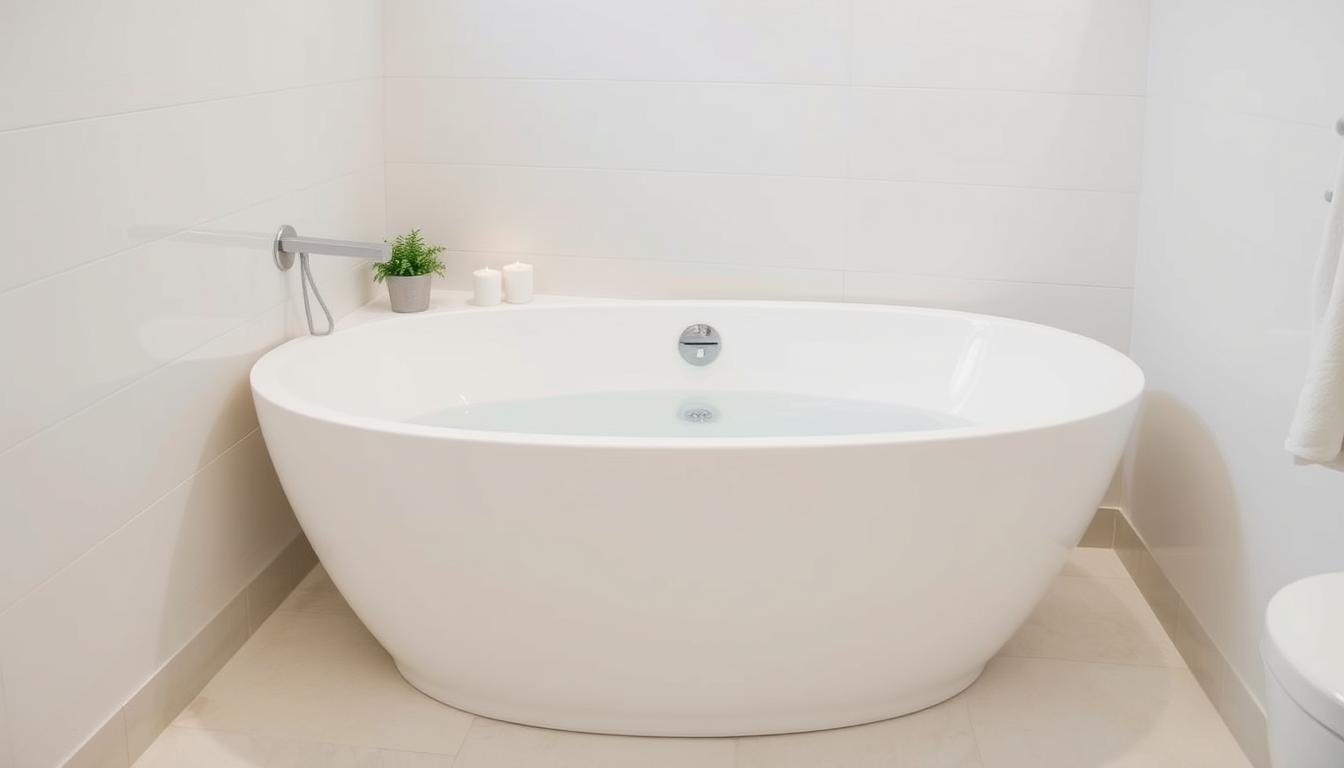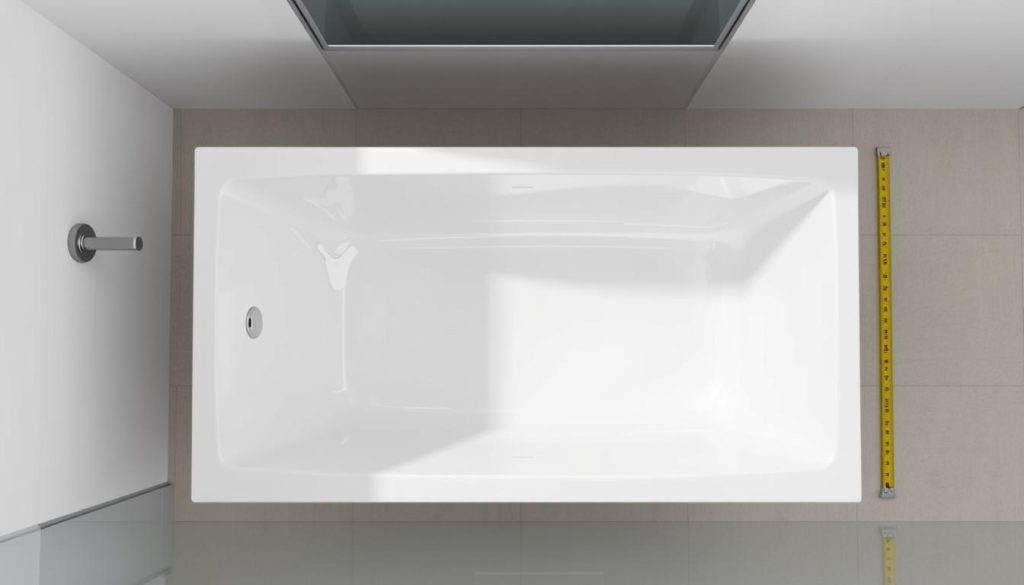
A typical bathtub can hold up to 264 liters (70 gallons) of water. This fact shows how much water bathtubs can store. Bathtub volume varies based on size, shape, and style.
Knowing bathtub capacity is important for several reasons. It helps when choosing a new tub for bathroom renovations. You can make sure it fits your needs and likes.
Understanding water capacity also aids in saving water. You can better monitor and manage your water use. This knowledge leads to a more eco-friendly and enjoyable bathroom experience.
Standard Bathtub Sizes and Capacities
Choosing the right bathtub requires knowledge of standard sizes and capacities. This info helps you pick based on your bathroom’s layout and needs. Let’s explore common dimensions, water capacity, and factors affecting bathtub volume.

Common Bathtub Dimensions
Typical alcove baths measure 60 inches long, 30 inches wide, and 14 to 16 inches high. Sizes vary to fit different bathrooms and preferences. Soaking tubs range from 60 to 72 inches long with 14-inch depth or more.
Oversized tubs exceed 70 inches in length. They have a soaking depth of 16 inches or more.
Water Capacity of Standard Bathtubs
Bathtub water capacity is key for calculating volume and household water use. Smaller tubs hold about 40 gallons (150 liters). Standard bathtubs can fit 50-70 gallons.
Large or double bathtubs have greater capacity. They can hold 80 to over 170 gallons.
| Bathtub Type | Water Capacity (Gallons) | Water Capacity (Liters) |
|---|---|---|
| Small Bathtubs | 40 | 150 |
| Standard Bathtubs | 50-70 | 189-265 |
| Large/Double Bathtubs | 80-170+ | 303-644+ |
Factors Affecting Bathtub Volume
Several factors influence a bathtub’s water-holding capacity. These include:
- Bathtub shape: Rectangular, oval, corner, or freestanding tubs have different capacities due to their unique designs.
- Bathtub depth: Deeper tubs hold more water than shallower ones. Regular tubs can be up to 18 inches deep.
- Bathtub dimensions: The overall length, width, and height of the tub directly impact its water capacity.
Understanding bathtub specifications, including dimensions and water capacity, is essential for calculating bathtub water volume and selecting the right tub for your home.
Knowing standard bathtub sizes and capacities helps you choose wisely. Consider your needs, preferences, water usage, and gallons to liters conversion. This knowledge ensures you pick the perfect tub for your home.
How Many Liters Can a Bathtub Hold?
Bathtubs come in various sizes and volumes. Knowing a bathtub’s water capacity is crucial for practical and environmental reasons. Let’s explore the factors that affect a bathtub’s water capacity.
Calculating Bathtub Water Volume
To find a bathtub’s water volume, measure its dimensions. Multiply length by width and depth. Different bathtub shapes may need adjustments to this calculation.
Here are some estimates for different bathtub types:
- Standard alcove bathtubs have a full capacity of around 180 liters, but people usually fill them halfway, using approximately 100 liters.
- Oval bathtubs, despite being wider than alcove ones, also use around 100 liters of water when filled.
- Freestanding bathtubs can hold anywhere from 340-378 liters, designed for single-person bathing.
- Corner bathtubs can usually hold roughly anywhere from 150-227 liters, designed for confined spaces.
Liters vs. Gallons: Understanding the Difference
Liters are the metric unit of volume. Gallons are the imperial unit used in the United States. One gallon equals 3.785 liters.
To convert gallons to liters, multiply by 3.785. For example, a 70-gallon bathtub holds about 265 liters of water.
Bathtub Capacity Comparison: Small, Standard, and Large Tubs
Bathtubs come in various sizes for different needs. Here’s a comparison of water capacity for small, standard, and large bathtubs:
| Bathtub Size | Dimensions (mm) | Water Capacity (Liters) |
|---|---|---|
| Small | 1400-1600 | 140-180 |
| Standard | 1700 | 190-200 |
| Large | 1800+ | 210+ |
Larger bathtubs hold more water but require more energy to heat. They may not be as eco-friendly as smaller tubs or showers.
On average, a bath uses 132-264 liters of water. A ten-minute shower uses about 94 liters.
Conclusion
Knowing your bathtub’s capacity is key for saving water and helping the environment. This knowledge helps you make smart choices about bathing habits. You can always find ways to save water, no matter your tub’s size.
Installing efficient plumbing fixtures is a great way to cut water use. Low-flow showerheads and faucets can save water without ruining your bath time. Being mindful of how long you bathe can also make a big difference.
By saving water and knowing your tub’s capacity, you help protect our planet’s most precious resource. Small changes, like shorter showers, can have a big impact. Together, we can create a more sustainable future for everyone.







